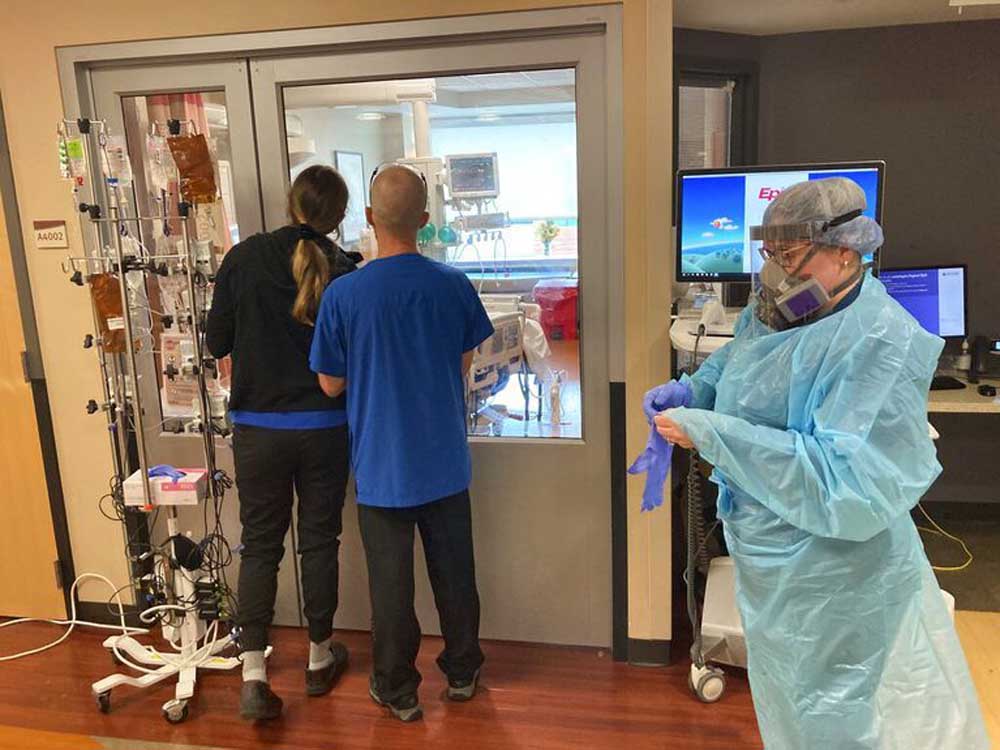Virus hospitalizations could peak on Labor Day
Published 12:46 pm Friday, August 27, 2021

- Two visitors peer into the room of a COVID-19 patient in the intensive care unit at Salem Hospital in Salem as a nurse dons full protective gear before going into the room of another patient.
The steep rise in COVID-19 cases that began in July could peak on Labor Day and begin a two-month decline, according to a new state report.
The COVID-19 forecast released Thursday by Oregon Health & Science University in Portland included an updated scenario of hospitalizations.
“The forecast shows a peak census level of 1,197 on 9/6,” wrote Dr. Peter Graven, the chief COVID-19 analyst at OHSU.
Hospitalizations would make a painful retreat with earlier low levels of virus hospitalizations unlikely until late October — just before Halloween.
Graven said the toll on the state has been heavy and will continue for weeks ahead with levels of cases remaining high as the virus retreats. Oregon is experiencing the highest rate of virus cases of the 18-month pandemic.
The rapid influx of unvaccinated people arriving with severe infections has pushed the state’s network of medical centers to the breaking point.
“We’re seeing the number of people hospitalized going up at rates we’ve never seen before,” Graven said.
While there is now hope that the spike driven by the highly contagious delta variant could be slowing its rocket-like trajectory, there will be a long, costly fall back to levels seen before the spike.
COVID-19 hospitalizations could fall to about 200 patients around Oct. 23. The decline would continue until reaching pre-spike levels around Nov. 6. The forecast shows hospitalizations could continue to near zero by Christmas.
The Oregon Health Authority has reported that 95% of hospitalizations and deaths during the last two months have been among unvaccinated people.
Among vaccinated people with breakthrough cases, 5.5% have been hospitalized and 0.9% have died. The median age of the vaccinated people who died was 83.
Dr. Renee Edwards, OHSU’s chief medical officer, speaking Wednesday during a media briefing prior to the official release of the report, said the crisis remains dire.
Hospitals reported over 92% of all adult staffed beds were occupied. Intensive care unit beds often had even fewer openings. Reports of patients backing up into emergency rooms and ambulances unable to bring in new patients came from around the state.
Compounding the problem: Oregon has the lowest per-capita supply of hospital beds in the nation at 1.7 beds per 1,000 residents, according to the Kaiser Family Foundation, a health issues nonprofit. South Dakota ranks first, with 4.8 beds per 1,000.
The death of a patient in Douglas County waiting in an emergency room because of not enough intensive care unit beds being available made international news.
Edwards said a graphic of the spike showed a roughly symmetrical rise and fall, with the increase from early July mirroring the projected drop over a similar period.
“The downward angle looks kind of exactly like the upward angle, that the path back down would look just as steep and long as the path up,” Edwards said.
OHSU scientists underlined that the forecast peak was not the end, but the middle of the crisis. An equal number of unvaccinated people are expected to get sick during the next two months.
Progress toward improvement could stall if residents get “COVID fatigue” and become complacent about masking, getting vaccinated and other safeguards. The delta variant has increased cases twelvefold since early July.
Unvaccinated people are also a potential breeding ground for new variants, which could be even more contagious and virulent than the delta variant.
OHSU reported Thursday that just over 63% of all Oregon residents are vaccinated. That includes children under 12, for whom there is no federally approved vaccine. Oregon ranks 19th in the nation for overall vaccination rate.
Edwards said that until most of the world is immune, variants could come from the next city or from around the world.
“That’s what viruses do,” Edwards said. “Viruses are constantly changing and mutating and looking for their best opportunity to spread.”
Oregon could approach herd immunity — in which the total number of people who are either vaccinated or been exposed to the COVID-19 through transmission slows or stalls the ability of the virus to spread.
Edwards said Wednesday that Graven’s forecasts have shown reaching herd immunity is possible — but at a much greater human cost than through vaccination.
“Dr. Graven said we are getting to herd immunity, but through mass infection, which is not the way to get there because too many people get sick, too many people die and it overwhelms our health care system,” she said.









